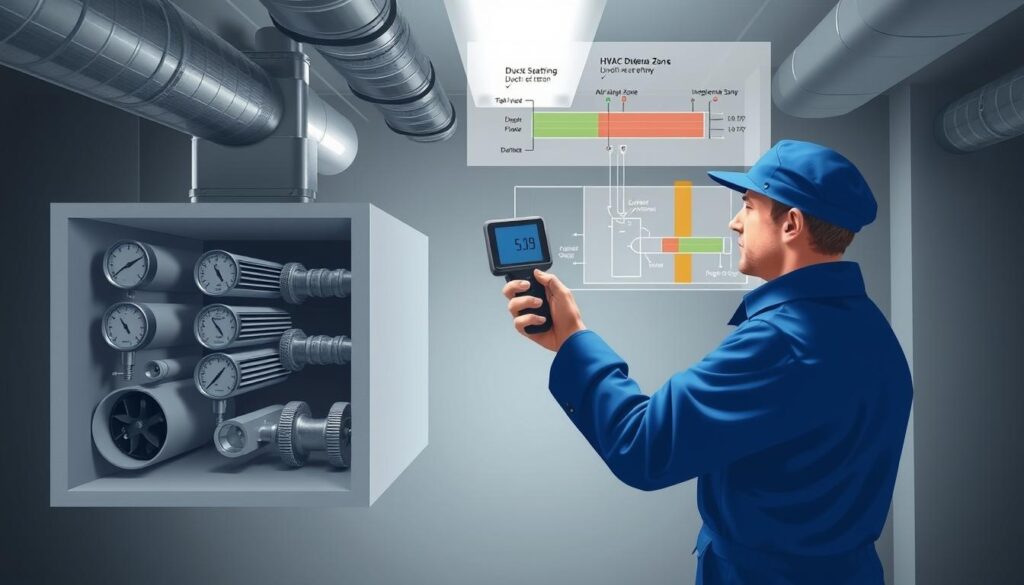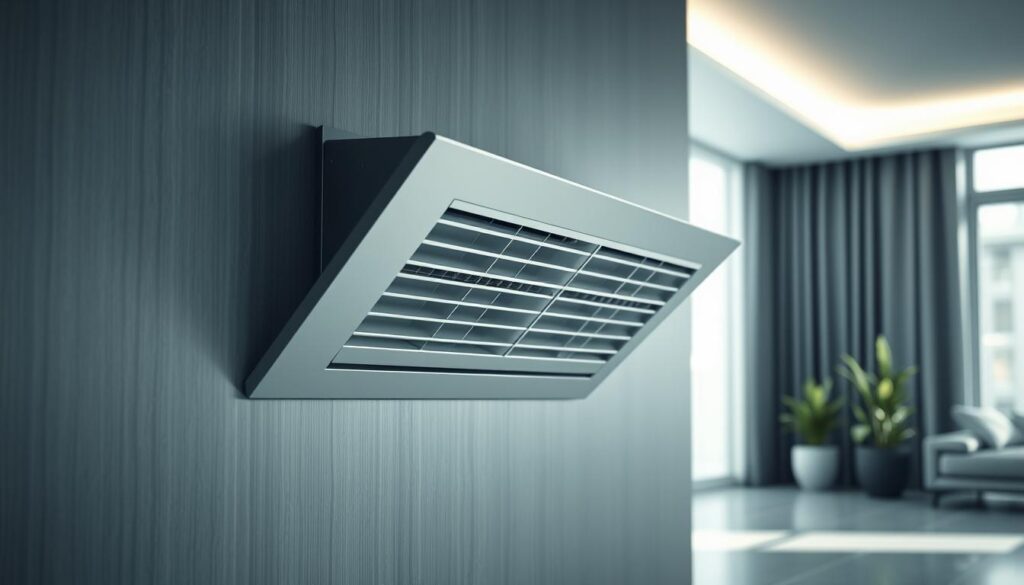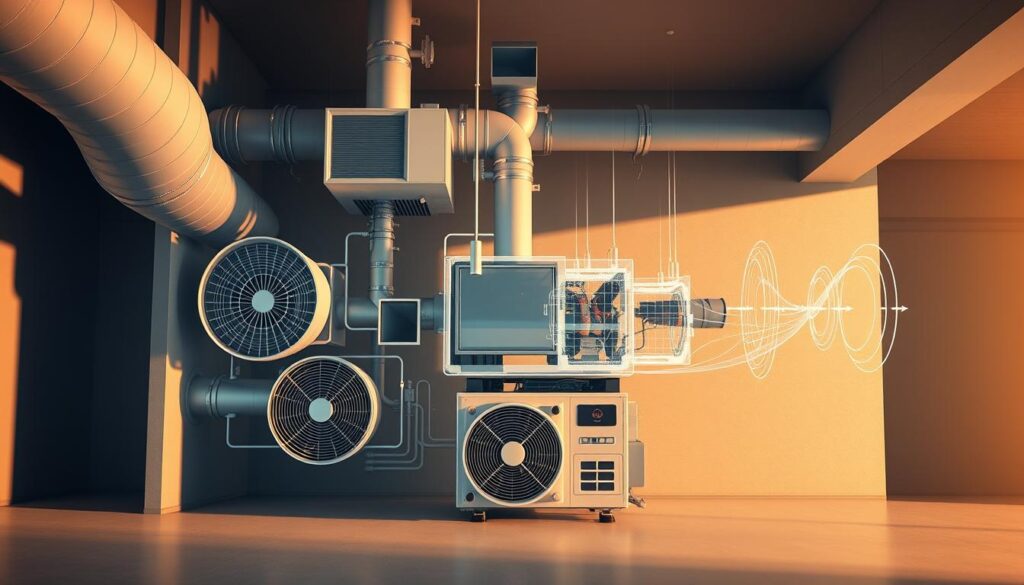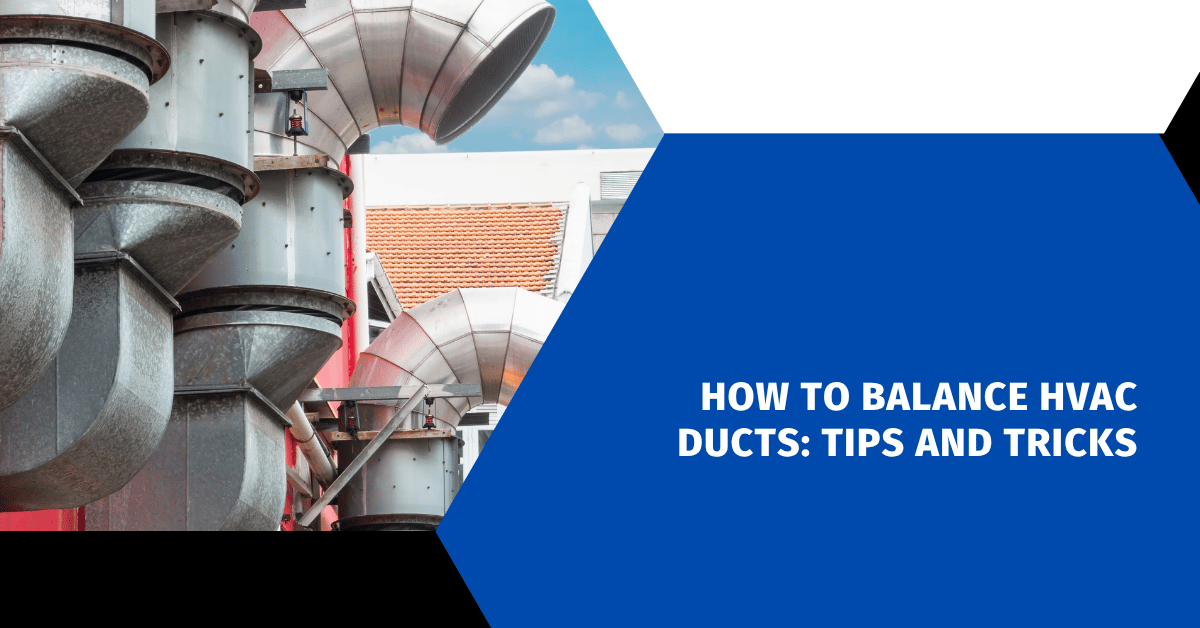Affiliate Disclosure
HVAC Guide Guys is a participant in the Amazon Services LLC Associates Program, an affiliate advertising program designed to provide a means for sites to earn advertising fees by advertising and linking to Amazon.
How to Balance HVAC Ducts? Ever noticed how some rooms in your home are freezing, while others are sweltering? The answer is in balancing your HVAC ducts for better comfort and energy use.

Getting air flow right in your ducts is key to a cozy home. Your HVAC system tries to spread air evenly, but without balance, some spots get too hot or cold.
To master duct balancing, you need to know your home’s air flow patterns. This ensures each room gets the right air, boosting comfort and saving energy.
Key Takeaways
- Proper duct balancing improves home comfort
- Unbalanced systems can lead to temperature inconsistencies
- Airflow optimization reduces energy consumption
- Regular HVAC maintenance prevents performance issues
- Professional assessment can identify complex airflow problems
Table of Contents
Understanding HVAC Air Balancing Basics
Your home’s comfort is more than just an HVAC system. Proper air distribution is key for a cozy living space. When your system works well, you get even temperatures and better energy use.
HVAC system balancing is vital for good indoor climate control. It’s like tuning an instrument. Each part must work together for the best sound, or in this case, temperature.
What is Air Balancing?
Air balancing adjusts your HVAC system for even air flow in your home. It involves several steps:
- Measuring airflow in different rooms
- Identifying temperature variations
- Adjusting dampers and vents
- Ensuring consistent air pressure
Why Balanced Airflow Matters
Unbalanced HVAC systems cause hot and cold spots. Imagine one room feeling like a freezer while another feels like a sauna. Balanced air flow stops these issues and makes your system more efficient.
Common Causes of Unbalanced Systems
Several things can mess up your HVAC’s air balance:
- Poorly designed ductwork
- Blocked or dirty air vents
- Incorrect system sizing
- Natural home settling and structural changes
Knowing about HVAC system balancing can make your home more comfortable. It might also cut down on energy costs.
Signs Your HVAC System Needs Balancing
Knowing when your HVAC system needs balancing can save you money and make your home more comfortable. Spotting specific warning signs is the first step to solving uneven cooling issues.
How consistent your home’s temperature is can tell you a lot about your HVAC’s performance. Big temperature differences between rooms often mean airflow problems. If some rooms are way too hot or cold, it’s time to check your duct system’s balance.
- Temperature differences of 2-3 degrees between rooms
- Unexpectedly high energy bills
- Rooms that feel consistently uncomfortable
- Weak or inconsistent airflow from vents
Watch for these signs to improve your heating efficiency with duct balancing. Whistling sounds from vents, rooms that never get to the right temperature, and uneven air distribution all point to a need for professional help.
Changes in your energy use can also hint at problems. If your bills suddenly go up without reason, your HVAC might be working too hard because of airflow issues. Regular checks can stop long-term problems and damage to your system.
Proactive homeowners know that catching HVAC imbalances early can avoid expensive fixes and boost system performance.
Explore Our HVAC Shop
Looking for top-rated HVAC tools, parts, and accessories? Visit our shop and find the perfect solution for your needs.
Visit the ShopEssential Tools and Equipment for Duct Balancing
To get your HVAC system working right, you need the right tools. Knowing what tools are needed for adjusting dampers is key. It makes a big difference in how well your system works and how efficient it is.
Professional HVAC techs use special tools to make sure air flows right in your home or building. These tools help find and fix any problems with air flow.
Manual Dampers: Precision Control Mechanisms
Manual dampers are very important for controlling air in your HVAC system. They work like valves. You can:
- Control air to different rooms
- Change how much air flows with a simple handle move
- Make sure temperatures are even in different areas
Air Flow Measurement Tools
Getting accurate measurements is key for making your HVAC system better. You’ll need:
- Anemometers: To measure how fast and much air moves
- Digital flow hoods: For exact air flow readings
- Pressure gauges: To see if your system is working right
Vent Adjustment Equipment
Adjusting vents needs special tools. These tools help techs make your HVAC system work its best. They make sure air flows just right.
Using top-notch tools can really boost your HVAC system’s performance and comfort.
Explore Our HVAC Shop
Looking for top-rated HVAC tools, parts, and accessories? Visit our shop and find the perfect solution for your needs.
Visit the ShopHow to Balance HVAC Ducts: Step-by-Step Process
Residential duct balancing can make your home more comfortable and energy-efficient. Whether you love DIY projects or just want to learn about your HVAC system, this guide is for you. It will show you how to balance your ducts yourself.
- Locate Your HVAC System
First, find your furnace or air conditioner. Then, trace the ductwork in your home. This step helps you see how air flows through your home.
- Activate the Fan
Turn on your system’s fan. This lets you check how well air moves in each room. Use an airflow meter to measure the air flow.
- Assess Room Airflow
Check the temperature and air movement in different rooms. Look for rooms with weak or strong airflow. Use your measurements to find these areas.
Diy duct balancing needs patience and careful adjustments. Here’s a quick guide for managing airflow:
| Airflow Condition | Recommended Action |
|---|---|
| Low Airflow Rooms | Open dampers or louvers to increase air circulation |
| Medium Airflow Rooms | Adjust vents for optimal distribution |
| High Airflow Rooms | Reduce air volume by partially closing dampers |
Make small changes and let your system adjust between them. Run the system for at least 15 minutes after each change. This lets you see how it affects your home.
Pro Tip: Keep a log of your adjustments. This will help you see which changes make your home more comfortable.
Understanding Damper Adjustment Techniques
Getting your home just right in terms of comfort needs some finesse with manual damper adjustment. Your HVAC system’s performance is all about controlling airflow. Knowing how to adjust dampers is key to keeping your home at the perfect temperature and running efficiently.
Dampers play a big role in your HVAC system. They control the air flow through your ductwork. Think of them as valves, directing air to different parts of your home.
Locating Dampers in Your System
Spotting dampers in your ductwork takes some effort. You’ll usually find them:
- Near main trunk lines
- Close to room branch connections
- Inside rectangular or round metal ducts
Proper Damper Operation
Learning how to balance your HVAC system starts with knowing how to use dampers. The damper’s handle tells you a lot:
- Parallel to duct: Damper is fully open
- Perpendicular to duct: Damper is completely closed
- Intermediate angles: Partial airflow adjustment
Seasonal Adjustment Strategies
Each season brings its own needs for air flow. In summer, upper floors might need more cooling. In winter, focus on warming up living areas. Making small, gradual changes helps keep your system balanced and your HVAC equipment happy.
Pro tip: Always make small, measured changes when performing manual damper adjustment to prevent sudden system stress.
Explore Our HVAC Shop
Looking for top-rated HVAC tools, parts, and accessories? Visit our shop and find the perfect solution for your needs.
Visit the ShopOptimizing Supply and Return Vents

Getting air flow right in ducts is key. Your HVAC system’s supply and return vents are crucial. They help keep your home comfortable and save energy.
Supply vents send cool air into your rooms. To get the most out of them, try these tips:
- Adjust louver angles to direct airflow effectively
- Keep vents unobstructed by furniture or curtains
- Clean vents regularly to prevent dust buildup
Proper positioning of supply vents can dramatically improve your room’s temperature distribution. Strategically placed vents can make your home more comfortable.
“Effective vent management is the key to optimal HVAC performance” – HVAC Engineering Professionals
Return vents pull air back into the system for cooling. To keep them working well:
- Maintain clear pathways around return vents
- Check for any blockages that might restrict airflow
- Replace air filters regularly to prevent system strain
By optimizing your vents, you can boost your home’s air flow and comfort.
Professional vs DIY Air Balancing Methods
Choosing between professional and DIY duct balancing can be tough for homeowners. Your choice depends on your skills, time, and the system’s complexity.
DIY duct balancing needs careful thought about your home’s heating and cooling needs. Some can handle basic air balancing, but others might need a pro.
When to Call a Professional
Here are times when you should call a pro:
- Complex multi-story home layouts
- Older HVAC systems with intricate ductwork
- Significant temperature variations between rooms
- Limited personal technical experience
Cost Considerations
Professional duct balancing costs $750 to $2,000 for a single-family home. Prices change based on:
- Home square footage
- Ductwork complexity
- Number of HVAC zones
- Required diagnostic testing
Certification Requirements
When hiring a pro, look for NATE (North American Technician Excellence) certified techs. They show they know a lot about HVAC system maintenance and air balancing.
Professional help can save you money and prevent HVAC system damage in the long run.
Explore Our HVAC Shop
Looking for top-rated HVAC tools, parts, and accessories? Visit our shop and find the perfect solution for your needs.
Visit the ShopMaintaining Balanced Airflow Year-Round

Keeping your HVAC system in top shape needs ongoing effort and smart maintenance. Hvac airflow optimization is a continuous task. It keeps your home cozy all year long.
To boost heating efficiency with duct balancing, try these key steps:
- Do seasonal system checks every six months
- Change or clean air filters often
- Adjust dampers for temperature changes
- Seal air leaks in ducts
Your home’s comfort relies on regular HVAC upkeep. Using these methods stops hot spots and cuts energy use. Regular checks stop system problems that raise your bills.
In winter, send warm air to cooler rooms. In summer, make sure air flows well and evenly. Watching your system helps you fine-tune airflow.
Consistent maintenance is the key to a perfectly balanced HVAC system.
Experts say get a full system check-up every year for best performance and energy use. Being proactive and tweaking little by little keeps your home comfy and saves on energy.
Conclusion
Balancing your HVAC ducts is key for home comfort and saving energy. Learning how to do this can make your system work better and cut down on energy costs. You’ll make sure each room gets the right amount of air.
It’s not just about knowing how to balance ducts. It’s about making your home a comfortable place to live. Regular checks and upkeep of your ducts can stop uneven temperatures and save your HVAC system. You can do it yourself or get help from professionals.
Every home is different, and your HVAC system needs special care. Spend time learning what your home needs. Use the right tools and ask for help when you need it. With the tips from this guide, you can make your home more comfortable and energy-efficient.
Start now to check and balance your HVAC ducts. Your home, your energy bills, and your HVAC system will all benefit from it.

